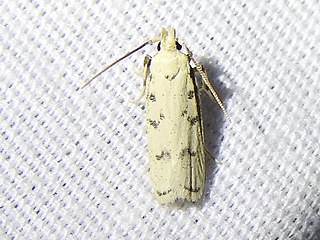
Glyphidocera is a genus of moths in the family Autostichidae.
Glyphidocera tibiae is a moth discovered at two collection sites in Costa Rica in 2005 by David Adamski. With coloring ranging from dark brown on the legs to pale brown hindwing and yellow brown undersurface it is similar to Glyphidocera Novercae also found in Cost Rica around the same time. G. Noverae however has more yellowish features and a more protuberant ventral furca, among other differing features.
Glyphidocera acuminae is a moth in the family Autostichidae. It was described by Adamski and Brown in 2001. It is found in Venezuela.
Glyphidocera basipunctella is a moth in the family Autostichidae. It was described by Adamski and Brown in 2001. It is found in Venezuela.
Glyphidocera brevisella is a moth in the family Autostichidae. It was described by Adamski and Brown in 2001. It is found in Venezuela.
Glyphidocera brocha is a moth in the family Autostichidae. It was described by Adamski and Brown in 2001. It is found in Venezuela.
Glyphidocera brunnella is a moth in the family Autostichidae. It was described by Adamski and Brown in 2001. It is found in Venezuela.
Glyphidocera castanella is a moth in the family Autostichidae. It was described by Adamski and Brown in 2001. It is found in Venezuela.
Glyphidocera chungchinmookara is a moth in the family Autostichidae. It was described by Adamski and Brown in 2001. It is found in Venezuela.
Glyphidocera dentata is a moth in the family Autostichidae. It was described by Adamski and Brown in 2001. It is found in Venezuela.
Glyphidocera digitella is a moth in the family Autostichidae. It was described by Adamski and Brown in 2001. It is found in Venezuela.
Glyphidocera garveyi is a moth in the family Autostichidae. It was described by Adamski and Brown in 2001. It is found in Venezuela.
Glyphidocera glowackae is a moth in the family Autostichidae. It was described by Adamski and Brown in 2001. It is found in Venezuela.
Glyphidocera hamatella is a moth in the family Autostichidae. It was described by Adamski and Brown in 2001. It is found in Venezuela.
Glyphidocera janae is a moth in the family Autostichidae. It was described by Adamski and Brown in 2001. It is found in Venezuela.
Glyphidocera lunata is a moth in the family Autostichidae. It was described by Adamski and Brown in 2001. It is found in Venezuela.
Glyphidocera plicata is a moth in the family Autostichidae. It was described by Walsingham in 1911. It is found in Panama.
Glyphidocera dimorphella is a moth in the family Autostichidae. It was described by August Busck in 1907. It is found in North America, where it has been recorded from Florida, Maine, Maryland, New Hampshire, South Carolina and Texas.
Glyphidocera dominicella is a moth in the family Autostichidae. It was described by Walsingham in 1897. It is found in the West Indies, where it has been recorded from Dominica.

Glyphidocera lactiflosella, the five-spotted glyphidocera moth, is a moth in the family Autostichidae. It was described by Vactor Tousey Chambers in 1878. It is found in North America, where it has been recorded from Alabama, Arkansas, Florida, Georgia, Louisiana, Maine, Mississippi, North Carolina, South Carolina, Tennessee and Texas.

